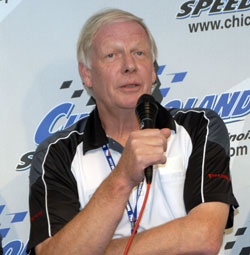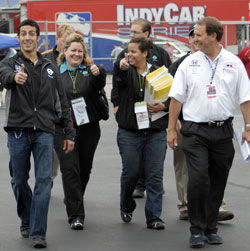 Indiana Lt. Gov. Becky Skillman honored the first three recipients of the Paul Dana Leadership in Biofuels Awards on Aug. 28 in a ceremony at the Indiana State House.
Indiana Lt. Gov. Becky Skillman honored the first three recipients of the Paul Dana Leadership in Biofuels Awards on Aug. 28 in a ceremony at the Indiana State House.
The recipients of the 2006 Paul Dana Leadership in Biofuels Award are Kellie Walsh, executive director of the Central Indiana Clean Cities Alliance; Dr. Mike Ladisch, a professor at Purdue University who directs the school’s laboratory of renewable resources engineering; and Jon Lantz, vice president of supply and marketing for Countrymark Coop. Pictured with the winners are Skillman and Indiana Agriculture Director Andy Miller (on either side of Kellie Walsh).
The award, announced during 90th Indianapolis 500 activities in May at the Indianapolis Motor Speedway, was named in memory of Indy Racing League IndyCar Series driver and biofuels advocate Paul Dana. Notice that the awards are replicas of Dana’s helmet in the photo.
“Paul Dana was a man who understood the incredible upside to the development and use of biofuels,” said Skillman. “He could see the many benefits biofuels offer to our nation, to our environment and to our farmers. He used his position and energy to make great strides in this area. The three individuals we honor today are examples of the dedication and vision that marked Paul Dana’s life and legacy.”
Read more on drivingethanol.org.
(Winners photo from Ron McQueeney Indy Racing League)


 Got a call today from
Got a call today from  President and CFO Alex Conger owns this bright yellow Hummer, named “Ethyl,” that runs on 98 percent ethanol using the FullFlex system and he says he actually gets better fuel mileage with ethanol using the system than with regular gasoline!
President and CFO Alex Conger owns this bright yellow Hummer, named “Ethyl,” that runs on 98 percent ethanol using the FullFlex system and he says he actually gets better fuel mileage with ethanol using the system than with regular gasoline!
 The US Secretaries of Agriculture and Energy last week were out promoting the upcoming Renewable Energy Conference in St. Louis.
The US Secretaries of Agriculture and Energy last week were out promoting the upcoming Renewable Energy Conference in St. Louis. Biodiesel’s role in improving air quality was the focus of a lung association forum last week, according to a release from the
Biodiesel’s role in improving air quality was the focus of a lung association forum last week, according to a release from the  The race is over and it was an exciting one. As usual this season, ethanol wins.
The race is over and it was an exciting one. As usual this season, ethanol wins. Here’s an early shot as the Team Ethanol goes by after getting the green flag.
Here’s an early shot as the Team Ethanol goes by after getting the green flag. The race is on. The weather seems to be cooperating.
The race is on. The weather seems to be cooperating. On the podium for this morning’s press conference on ethanol are (l – r) Jeff Simmons, #17 Team Ethanol driver, Les McTaggert, IRL Senior Technical Director and Tom Slunecka, Executive Director for the Ethanol Promotion and Information Council.
On the podium for this morning’s press conference on ethanol are (l – r) Jeff Simmons, #17 Team Ethanol driver, Les McTaggert, IRL Senior Technical Director and Tom Slunecka, Executive Director for the Ethanol Promotion and Information Council. Les talked about the conversion to ethanol as a fuel blend this year and going into next year. He describes the challenges it presented and the testing required to make sure it would meet the demanding performance needs of IRL cars. He said that race cars using 100 percent ethanol would be tested on the track within the next month.
Les talked about the conversion to ethanol as a fuel blend this year and going into next year. He describes the challenges it presented and the testing required to make sure it would meet the demanding performance needs of IRL cars. He said that race cars using 100 percent ethanol would be tested on the track within the next month. I can hear engines rumbling as I write this post and that’s a good sign. Maybe the weather will give us a break for a while so we can get this race off.
I can hear engines rumbling as I write this post and that’s a good sign. Maybe the weather will give us a break for a while so we can get this race off. The weather may not be cooperating here in Joliet but that’s allowing a lot of people to get some pretty detailed garage tours.
The weather may not be cooperating here in Joliet but that’s allowing a lot of people to get some pretty detailed garage tours.